|
Hunting in Bear Country
Proper Preparation
Hunting in bear country requires special equipment, skills and precautions. Properly prepare for your hunt.
 Special Equipment Checklist: Special Equipment Checklist:
- EPA registered bear spray (at least 1 canister per hunter or staff).
- Pulley systems & ropes (for hanging game & food storage).
- Drop cloth for relocating game.
- Gloves & apron for handling game.
- Cell phone or hand-held 2-way radio.
- First Aid Kit.
- Most recent Food Storage & Game Handling regulations.
On the Hunt
|

|
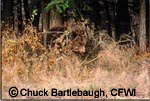
|
|
Sometimes bears are hard to see!
Sometimes bears are easy to see!
|
|
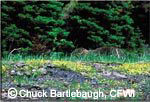
|
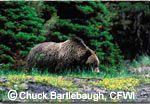
|
|
Hunters should be very aware of their surroundings. Here are tips to help avoid confrontations with bears.
- Avoid hunting alone.
- Learn to recognize bear sign, and avoid areas with fresh scat, diggings, tracks or carcasses.
- Be cautious in dense timber or brush and along creeks and waterfalls.
- Always remain alert for sudden encounters.
Carry EPA registered bear spray. The recommended spray distance is 25 feet with a spray duration of at least 6 seconds.
Do you know your Bears? Go here & take the test!
Handling Your Game
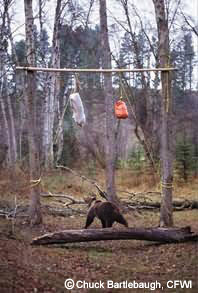 Have bear spray readily available. Have bear spray readily available.
- Wear gloves and apron (to minimize odors on clothing.
- Separate carcass from entrails, and remove carcass from area as soon as possible.
- Never leave entrails within 1 mile of a trail, campsite, picnic area or parking lot.
Carcasses should be kept unavailable to bears by hanging at least 10 to 15 feet from the ground and 4 feet out from the supporting structure; and 100 yards from any recreation site especially sleeping areas.
- Hang carcass where you can see it from a distance. That way you can observe it as you return.
- Items are considered unavailable to bears if they are:
- Stored in a closed, bear-resistant container.
- Enclosed within a vehicle constructed of solid, non-pliable material.
- Suspended at least 10 to 15 feet from the ground and 4 feet horizontally and vertically from any supporting tree or pole.
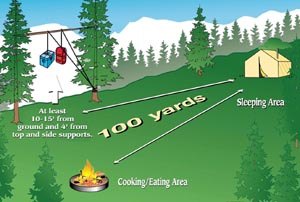 Food Regulations Food Regulations
- Human food and beverages, horse feeds, dog food, etc. either in possession of left unattended must be kept unavailable to bears unless being consumed, prepared for consumption or transported.
- When departing an area, remove all food and refuse from any bear resistant containers left in the area.
- Do not sleep in the same clothes that you handled game or cooked in.
- Keep sleeping bags, tents and sleeping area free of food and beverage odors.
- Keep bear spray readily available.
Bear Spray
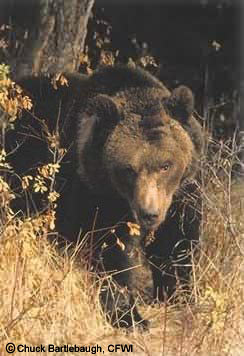 Bear Spray plays an important part in reducing attacks during human encounters with bears. It is proven to be an effective deterrent of North American bears, but it can be adversely affected by wind, rain, temperature, and even how close the bear is when it charges. Bear Spray plays an important part in reducing attacks during human encounters with bears. It is proven to be an effective deterrent of North American bears, but it can be adversely affected by wind, rain, temperature, and even how close the bear is when it charges.
When purchasing bear spray it is important to remember that personal defense sprays are not the same. Although both types of sprays are made from oleoresin capsicum, it is the capsaicin and related capsaicinoids that are the active ingredients in bear spray. Therefore, if you see claims on a large can that state 10%, 20% or 30% oleoresin capsicum, it is a personal defense spray, not bear spray.
The Environmental Protection Agency (EPA) regulates bear sprays pursuant to an Act of Congress. Look for the EPA registration and establishment numbers, usually found at the bottom of the front label. Only bear sprays will have this information. Also, bear spray labels will clearly refer to bears, and state it is a bear deterrent, bear repellent, or for stopping attacking bears.
Currently the EPA requires that the concentration of capsaicin and related capsaicinoids range between 1 and 2.0%. The variance in potency within this range is negligible, and all will affect the eyes, nose, throat and lungs of a bear. The minimum size can the EPA will register is 7.9 ounces, or 225 grams. Cans smaller than this may not have sufficient spray duration or distance to be used safely in deterring a charging bear.
Click here for a list of EPA approved Bear Sprays
(End of EPA Section)
"Bear spray or bullets"
Island Park News 9-17-09
 In 1999, the Center for Wildlife Information conducted a survey among bear management specialists, outfitters, guides, and people who had been involved in bear attacks. We interviewed Dr. Charles Jonkel, internationally known bear biologist and Carrie Hunt, wildlife biologist and bear conflict specialist, who in the mid ‘80’s and early ‘90’s conducted the only known formal research and testing on bear spray’s effectiveness and when and how it should be used. We asked them about different types of bear charge and attack scenarios and what they would recommend for minimum performance standards in a bear spray. In 1999, the Center for Wildlife Information conducted a survey among bear management specialists, outfitters, guides, and people who had been involved in bear attacks. We interviewed Dr. Charles Jonkel, internationally known bear biologist and Carrie Hunt, wildlife biologist and bear conflict specialist, who in the mid ‘80’s and early ‘90’s conducted the only known formal research and testing on bear spray’s effectiveness and when and how it should be used. We asked them about different types of bear charge and attack scenarios and what they would recommend for minimum performance standards in a bear spray.
- The minimum spray distance they recommended was 25 feet. (Over 90% of those surveyed would have liked to have the effective spray distance to be further away, but 25 feet was the minimum they considered to be acceptable.) This is for situations in which a bear is charging from a distance. You want the spray to create as wide a barrier between you and the bear as possible so it has the maximum amount of time to affect the bear’s eyes, nose, throat, and lungs.
- The minimum spray duration they recommended was 6 seconds. (Again, they would have preferred more time, but this was the absolute minimum they considered to be acceptable. Anything under that they considered to be unlikely to provide sufficient protection.) Their reasons for this recommendation was to ensure sufficient protection in a variety of bear charge/attack situations such as:
- More than one bear charging/attacking from different directions (mother with large cubs, mating pairs, siblings traveling together);
- Repeated charges/attacks (some bears will charge toward you, retreat, and charge again; others may circle around you and then charge);
- Defending yourself from a bear that turns on you after you have sprayed it to stop it from attacking someone else in your party;
- Exceptionally aggressive bears (a mother with cubs or a bear protecting a fresh kill);
- Weather conditions that may affect the spray (wind, rain, cold);
- Erratic spraying (fear factor causing some spray to be wasted because it is sprayed to soon, sprayed longer than necessary, or sprayed above the bear);
- Reserve spray for the hike out after a charge/attack.
Bear spray is a good last line of defense, but it is not a substitute for vigilance and following the appropriate safety techniques. Always give the bear a chance to leave, or for you to attempt to leave the area. Bear spray should only be used if you are charged by a bear. Point the canister towards the charging bear, slightly downwards, and if possible, spray before the bear is within 30-40 feet. Do not use bear spray to harass or chase animals out of your yard. Call your local wildlife management agency to assist you.
Compare the Grizzly and the Black Bear
|